| T O P I C R E V I E W |
| maryjane |
Posted - Oct 15 2015 : 8:00:40 PM
Thought a discussion about calcium supplements just before or after delivery and then again 12 hours later would be helpful. |
| 25 L A T E S T R E P L I E S (Newest First) |
| maryjane |
Posted - Mar 06 2019 : 08:19:16 AM
Keeley, I've always assumed the two you used were administered via IV. Correct me if I'm wrong.
I have three calves coming the first part of April, so I thought I'd revisit this thread and decide what I'm going to use. After giving it some thought and trying a bolus on Miss Daisy (not at all successful), I decided to buy 9 bottles of Durvet CMPK drench because we were able to successfully administer Corid to everyone here using a 400ml drench gun. Unlike a paste or a bolus, everything "flowed" a little easier once I put the girls one by one in my squeeze chute. It worked well on my calves, also. For that matter, a good quality, stainless steel tubing bladder (used to give a calf colostrum) would work (actually tried it to make sure). I bought the Durvet bottles at StateLineTack.com
.jpg?v 69914677)
I can't for the life of me remember where I bought the drench gun I've been using. For a while I used one that Dr. Parish gave me, but then it broke so I bought this one and it's been a real work horse (Corid has to be administered in three separate doses a few days apart).
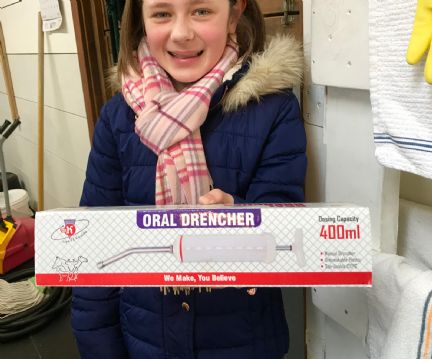


My plan is to make sure I can get one down all of them by giving them one when they seem close to delivery. Then again right after they calve, and then again 12 hours later.
|
| farmlife |
Posted - Aug 14 2018 : 09:25:23 AM
I'm so glad we have this topic. I will be much more preventative next time. MaryJane, you are so right about having options. It is so touchy right after calving we might not be able to just have one be all end all for every situation.
In light of that, when I got the liquid calcium from the vet she gave me two different kinds.
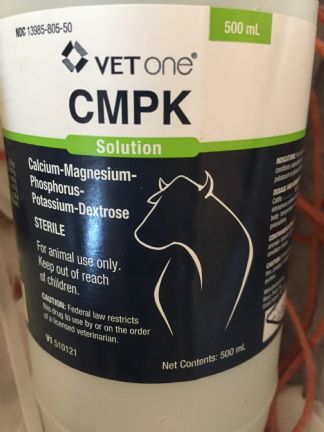
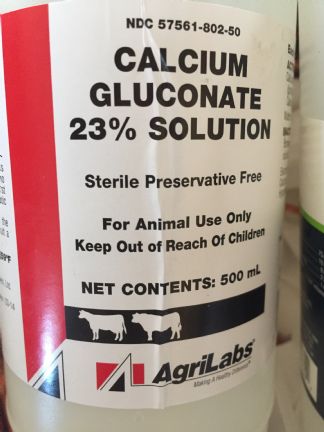
Elli got both and she was up within a few minutes. One had calcium, magnesium, phosphorus, potassium, and dextrose, and the other was calcium gluconate. It seemed to cover all the bases.
|
| NellieBelle |
Posted - Aug 14 2018 : 03:05:44 AM
https://crystalcreeknatural.com/shop/dairy/saf-cal/ Saf-Cal Here is a drench by Crystal Creek, however I don't see any Vitamin D listed. 1 oz. per 100 pounds. |
| maryjane |
Posted - Aug 13 2018 : 5:20:16 PM
Thanks Janet! |
| NellieBelle |
Posted - Aug 13 2018 : 2:17:19 PM
I will see if I can post a photo of the Transition balling gun for Jersey cow. The Transition bolus I purchased was dosage for Jersey cow also. Leedstone. http://www.leedstone.com/transition-balling-gun-2.html |
| maryjane |
Posted - Aug 13 2018 : 09:41:26 AM
My next births aren't until next spring but this time I'm going to assume any of them could come down with milk fever, rather than the other way around. Here's my prep so far.
A normal/commonly used calcium bolus is designed for large dairy cows and seems about the size of my forearm. I'm sure I couldn't fit one of those down any of my cows.
The Dr. Larson Company recently came up with a smaller bolus (for Jersey cows). It has calcium chloride, calcium propionate, calcium carbonate, and Vitamin D3. The ingredients in this one make the most sense to me. It has 22 grams calcium/bolus. They say the Vitamin D is "necessary for the absorption and metabolism of calcium and phosphorous" (which we know is the case for humans).
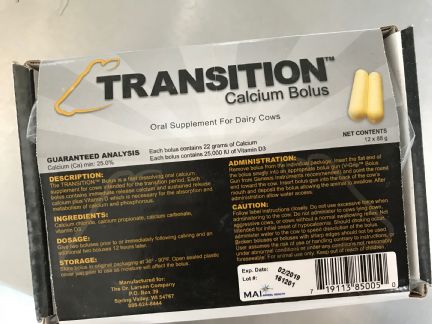
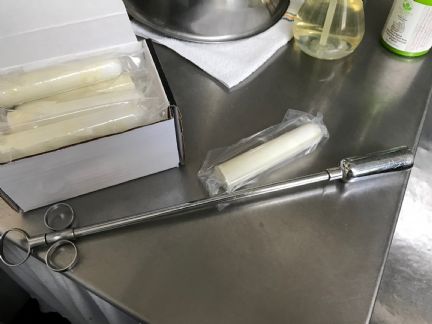
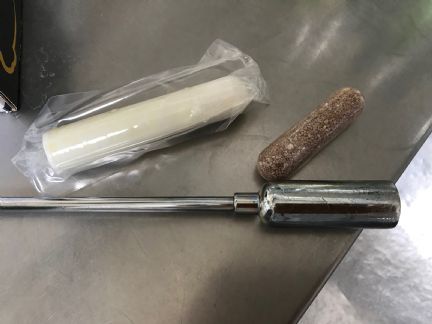
I got really good at giving Anna a bolus of ReaShure (the smaller brown one that is choline) two times per day using a balling gun. These are the size of the bolus and the gun I used. You can see that Dr. Larson's bolus is larger. I think Janet bought the balling gun that fits his bolus, but I haven't done that yet.
This is the gun that came with Dr. Larson's bolus but it can't be used by one person (me anyway) because the trigger to inject it down her throat is so far away.
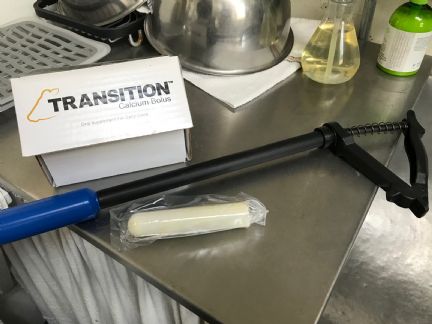
For an oral drench I purchased a 400 ml drench gun. I'm going to look into an oral drench I can put into it. I like a fair amount of calcium propionate in the mix and Vit. D. Perhaps CMPK or Unimix--haven't finished researching liquid mixes yet. For that matter, WSU gave me some powdered calcium propionate I could mix with water and give to her.
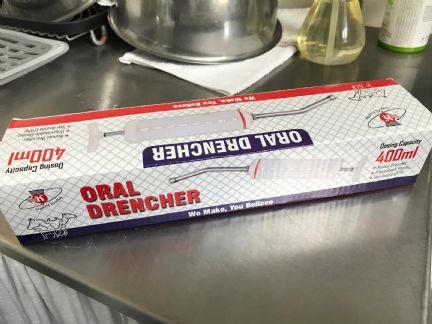
I also have some Van Beek CalCaps that fit the balling gun I do have. It has a different mix of ingredients but mainly it's calcium carbonate and propionate (one capsule 11 grams calcium--they recommend 4 to 5 of them post calving).
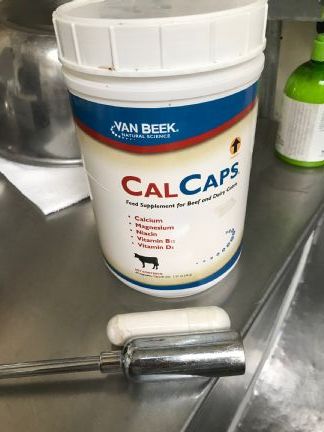
Because I know cows can be fickle and even more so right after calving, I'm going to offer my girls some options, thinking at least one of them has to work. I'm definitely going to try all three options prior to delivery to make sure all goes smoothly right after she gives birth and then again 12 hours later.
I'll let you know more once I get further along with my milk fever prevention testing. |
| maryjane |
Posted - Aug 13 2018 : 07:48:34 AM
Miss Daisy's milk fever wasn't at all straight forward. She delivered, was milked, colostrum fed to baby Buttercup (Miss Daisy's teats are too low to the ground for a calf--with her last calf I had to constantly pull its legs out from underneath it and hold it down on its belly so it could reach the teat.) Miss Daisy had eaten a good helping of Chaffhaye, all seemed well. I pulled up an upside down bucket to sit with her and Buttercup to watch for the afterbirth when she started to grind her teeth weirdly (learned since it's a pain response). Connie was getting ready to leave. I said, What do you think Daisy is doing with her teeth? We were looking at her mouth and brainstorming ideas when, Whoa, look at her side!!! She was starting to bloat. As it turns out, when they're low on calcium, their rumen quits contracting (calcium is needed for muscle function). We put her in the squeeze chute and tried unsuccessfully to tube her so I grabbed a laminated diagram/drawing of where to poke a cow I'd put on the parlor wall and Connie, hubby, and I successfully inserted a trocar in her side.
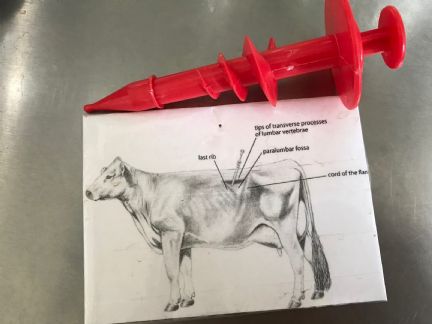
Her stomach went down immediately and she quit grinding her teeth but like Janet said, she was "bad drunk" so I knew we needed to get her to a vet for a calcium IV. Got her to the vet, IV inserted, calcium given (quick blood test also revealed she was low in phosphorous so she got some of that also). She perked up, we brought her home and she was fine for a day. The following day the young first-time vet who'd done the IV called to say she was going to stop by because she probably should have given Daisy antibiotics because of the trocar (the trocar can allow rumen juices to get in between skin and rumen--not a good thing), but it was too late. Daisy already had a systemic, full body infection raging. We had to administer lots of penicillin plus when she was laying on the vet's floor for the IV, she leaked milk on the dirty floor and a staph bug climbed up her teat, so we had to also treat that. Poor girl. In the meantime, our Maggie who'd delivered a week earlier agreed to adopt Daisy's calf and has successfully milked two calves all this time (I plan on weaning them next week--they'll both be 4 months old).
With my births going forward, I'm not going to withdraw alfalfa hay 10 days prior and right after birth she'll get a plug of calcium down the gullet. 12 hours later, she'll get another one. I kinda thought that after all these years, if I'd never had the dreaded milk fever, I must be doing something right with their diet. But no more leaving it to chance for me. I almost lost the cow I've had the longest through thick and thin. She's a super productive cow for her size, giving us 4 gallons every morning! |
| Boots&Flipflops |
Posted - Aug 10 2018 : 11:19:50 AM
Hi Everyone,
I am sorry to here about the Milk Fever issues happening to some of you. It is heart breaking.
Thought I would start a Forum for the subject so we can all find the info and share easily. I found this article and find it to be very informative. Lots of other great information on the left side bar as well. I believe the "Unimix" they talk about in prevention is very similar to the drench I gave Lacy as a preventative, and had no issues with milk fever. I used CMPK oral drench. One bottle ASAP after delivery, and then again 12 hours later.
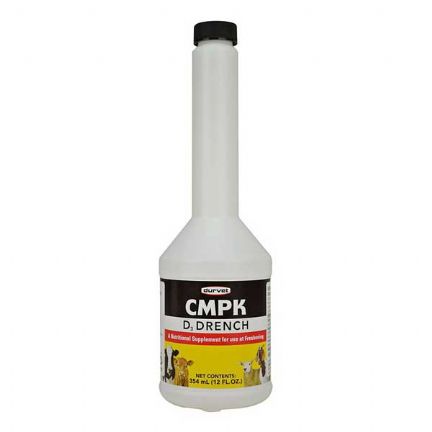
http://agriculture.vic.gov.au/agriculture/pests-diseases-and-weeds/animal-diseases/beef-and-dairy-cows/milk-fever-hypocalcaemia-in-cows |
| txbikergirl |
Posted - Apr 17 2016 : 1:47:32 PM
maryjane, as usual i soooo appreciate your comments. hugs from texas. i know most people are always hesitant to give anyone advice, but i know we all just give our opinions as to what we would do - and each person has to make their own decision. as i mentioned before, its really like raising children - lots of advice, and we've got to do what is right for us.
i liked that reference material you posted, that's what really gelled in my mind last night and made me really feel good about the realization that i have come to - if you want to keep a cow "all natural on pasture", then keep them natural and don't unnaturally increase their milk supply and unnaturally stress their body. don't mean that to sound like milking itself is unnatural - just that when we create the artificial demand we need to give them the nutrition required to do it.
I loved your analogy you posted about your breastfeeding experience and diet requirements - that's so true, and it resonates with me. that is what is natural. and the cows are experiencing it too.
and your comments are hitting what exactly i felt in my gut for months now. i want to cut out essentially all of the "supplemental" feeding - meaning chaffhaye, dairy grain, minerals, etc... BUT a small treat of the dairy grain isn't going to hurt. that little treat would probably make her day, and honestly will be the only reason she might return from the pasture to the barn!
i am going to keep her on the dry hay, its not alfalfa. from all my reading you need a balance of the dry hay for the proper health of the cow and their fresh pasture. that keeps her munching on something at night in the barn, and eager to get back to pasture each morning as well. i've also increased her barn corral size so she does have access to grasses/pasture mix there too for when i start the 3 day or so confinement for her to calve. |
| maryjane |
Posted - Apr 17 2016 : 12:17:34 PM
I'd posted this on another thread recently from a guy who runs a large raw milk dairy in S. Idaho.
"Many dairy cows may lose weight during the early stages of lactation due to energy requirements even with the best nutrition. If dairy cattle are not given the proper nutrition they need, they can get severely stressed and may be susceptible to infectious and metabolic diseases. Not only will the cow suffer, but also her milk production and quality. For example, ketosis and hypocalcemia are both common and quickly fatal metabolic diseases in dairy cattle that are caused by inadequate nutrition during lactation. Contrary to popular belief, year-round pasture feeding dairy cattle is NOT natural and is not the way dairy cattle have been historically managed. A good quality, high producing dairy cow cannot do well on green pasture alone. Even the best pasture does not contain the nutrition it needs to produce the milk it was bred to produce. Keep in mind that a grass fed dairy in Idaho only has grass available from April-Sept/Oct. Year round pasture feeding of dairy cattle requires the artificial creation of year-round pastures by intensive irrigation that uses high volumes of energy and water ... "
"Tim Boyd, a member of the WAP Foundation, comments on the subject of grassfeeding milking cows, "...[G]rass is very short on Phosphorus and calcium two of the three essential macro nutrients, and is very short on energy (starch) to give fuel to microbes to multiply to digest large amounts of protein. The average cow rations should be in the range of 16.5 percent protein, most grass we feed as pasture is 24 to 27% protein, essentially drowning the microbes in too much protein forcing the cow to starve given nothing or very little gets digested because the microbes have no energy to reproduce even though the cow eats constantly.... The key is to have the balance just right with dairy cows and that is very hard to do with grass, and remember we have the limited up take of calcium and phosphorus as mentioned earlier with grass alone.... WAPF to my knowledge has never promoted 100% grass fed given the two counties in the country that can do it cannot supply the country with products. Grass can be a good thing but it also can be abused and lead to the same results of CAFOs, just killing them with protein and instead of energy." |
| txbikergirl |
Posted - Apr 17 2016 : 11:47:15 AM
it is a very, very small percentage maryjane. we are almost all grasses. we hand broadcast a bit of clover, but not much in the pastures themselves as we wanted to ease into that with the cows on new pasture.
through loverboy's communication with those that know better is that we have less then 10% legumes. so we are probably in the .4-.5% grass pasture calcium ranges, as opposed to the .7% heavy legume. just walking it every day we can see that - almost all grasses. |
| maryjane |
Posted - Apr 17 2016 : 11:41:45 AM
What is the legume percentage in your pasture? Roughly. I know you have clover. Do you have any pasture that is mostly grasses? |
| txbikergirl |
Posted - Apr 17 2016 : 11:11:19 AM
i am trying to understand more about DMI and found a good article here about it (at least in terms i could understand) http://articles.extension.org/pages/19660/maximizing-dry-matter-intake-from-pastures
"A general rule of thumb for dairy cows is that they will eat 1.8–2.2% of body weight from forage DM. When pastures are managed well, they are highly digestible and 2.2% is more realistic. Research with cows fed only grass/clover pasture has shown that they will eat 3 to 3.25% of body weight. The 2.2% figure is a good starting point when grain will be supplemented. Some cows will eat more than 2.2% of body weight due to their production level or genetic merit."
if we are making decision on what/how much to feed cows then i guess we have to understand how to determine what they are getting on pasture. given we are heavy pasture grazers here, and our cows are grazing 12-13 hours per day our answers will be different from others with less pasture during certain seasons, or less acreage, or more/less quality of pasture.
this is all fascinating to me, but a bit confusing. i'll get there eventually. |
| txbikergirl |
Posted - Apr 17 2016 : 10:13:08 AM
i am moving my comments on "late pregnancy nutrition" to this thread as maryjane reminded me of it, and the reality is that the concern over nutrition at this stage is all centered towards avoiding the dreaded milk fever.
i have been reading all over, but this kinda summed up what maryjane was referencing, and in terms i could understand (i am a numbers person, and need the numbers otherwise i don't know what is good versus bad, etc.).
http://www.merckvetmanual.com/mvm/management_and_nutrition/nutrition_dairy_cattle/nutritional_requirements_of_dairy_cattle.html
from the "Calcium and Phosphorus" section towards the end...
"When calculating calcium requirements, newer nutritional models take into account the variability in calcium availability from different sources. This availability generally ranges from 75%–85% for inorganic calcium supplements to a low of 30% for forage sources of calcium. This approach makes it difficult to generate general recommendations for total dietary calcium concentrations across various diets. Generally, diets with large portions of forage from legume sources will have minimum calcium concentration requirements in the range of 0.71%–0.75%, while diets with forages from primarily grass (including corn silage) sources will have minimum calcium concentration requirements in the range of 0.42%–0.47%.
Two approaches are taken with respect to the calcium supply for dry cows, each with the objective of preventing milk fever, or parturient paresis (see Parturient Paresis in Cows). One approach is to place cows in a calcium-deficient state during the last 2–3 wk of gestation; the rationale is to stimulate parathyroid hormone secretion and skeletal calcium mobilization before calving. This makes calcium homeostatic mechanisms more responsive at the time of parturition, allowing cows to maintain serum calcium concentrations during lactation. This approach requires diets with calcium concentrations near 0.3% of dry matter. Such diets are difficult to formulate with available feedstuffs while still meeting other nutritional requirements. Another approach is to feed an acidifying diet, usually referred to as a diet with a low or negative dietary cation-anion difference (DCAD). The low-calcium diet approach is not additive with the DCAD approach to milk fever prevention. When low-DCAD diets are fed, total dietary calcium concentrations should be near 0.9%, which is substantially greater than the requirement for a dry cow on a conventional diet."
and here is where they comment on DMI:
"In mature cows, DMI as a percentage of body weight is lowest during the nonlactating, or dry, period. In most cows, DMI declines to its lowest rate in the last 2–3 wk of gestation. Typical DMI during this period is <2% of body wt/day, with intake rates depressed more in fat cows than in thin ones. Feed intake during this period has an important relationship to postpartum health, with low DMI and associated prepartum negative energy balance increasing the risk of postpartum disease. After calving, DMI increases as milk production increases; however, the rate of increase in feed consumption is such that energy intake lags behind energy requirements for the first several weeks of lactation."
Our situation:
- lover boy believes our pasture is closer to the .4% grass concentration than the .7% legume concentration
- the dairy feed we serve is in the .2% - .25% range
my first thoughts, if my thought process is correct, given all this lush pasture right now i should just take her off everything 2 weeks before she calves. is this what everyone else thinks it says? or in one of the last stmts where it says total dietary calcium concentrations should be near .9% does that mean keep her on the dairy feed since that is . 2% and the pasture would be and additional .4-.6%... to bring her to the .9%. and the last section on low DMI being a health risk also concerns me.
and then, i need to take into account that the dairy feed is only at the . 2% if in fact i feed them as much as they recommend, when in reality i have always used it as a supplement/treat and never fed the amounts for her weight that they say..
i am more confused now but will work my way through it. i had thought two weeks ago to remove everything but pasture and dry hay for the last few weeks, and for some reason got so confused in the last few days and was muddled. in fact, i had instructed lover boy to stop her grain a week ago and totally forgot that...
there is one broad overriding concept that i have to reconcile with everything else:
- if we have only two weeks to calve, and we have lush and nutritional pastures, then i shouldn't be capable to create deficient nutrition in her by eliminating outside inputs
- and wouldn't pulling everything else from her at this point be the conservative approach as it removes any chance of over consumption of alfalfa, calcium, etc. (but leave the dry hay free choice for her)
- and isn't this how nature works best? did we as humans in fact create this milk fever common occurrence by messing with the cows diet, wherein if given a healthy landscape and we left them alone for these past few weeks they would be ok
- and i have read several places that pulling all grain supplements a month or so before calving (when cow is dry of course) is best as it lets the gut work at its healthiest and not deal with the added grain. the natural rumen state is restored as it concentrates on what is normal in preparation for calving.
- and then when she calves, and i as the human create artifical stress on her body by increasing her milk supply i return to supplementing her diet with good healthy grain and stuff so that i dont tax her at that time
does anyone have any thoughts? i know i'll comprehend this better in a week when i take vacation and am not so tired, but i need to get it right starting now as we only have three weeks to calve... so the luxury of complete understanding isn't available to me at this exact moment. sigh
|
| maryjane |
Posted - Feb 29 2016 : 10:43:13 AM
I also think what we're up against is the fact that vet care (and supplies) and even the online information we have access to comes from a commercial standpoint. Generally those cows are bigger and the emotional investment is different--it tends to be more of a monetary investment. When I bump up against a problem, I feel like I have to dig through mountains of irrelevant solutions that have no practical application for me. Sometimes it's a mere customize job, other times I feel like I'm reinventing the wheel. |
| CloversMum |
Posted - Feb 29 2016 : 09:47:22 AM
Lesson learned, be pro-active so no need for re-active solutions. |
| Caren |
Posted - Feb 29 2016 : 09:41:34 AM
Thank you for the input, very valuable information. |
| farmlife |
Posted - Feb 29 2016 : 05:21:09 AM
I've heard it is quite caustic and actually irritates their throats and can "burn" as well. So it can put them off their feed and water and add another issue if it isn't truly needed. |
| CloversMum |
Posted - Feb 28 2016 : 5:41:46 PM
I can just see the cows running across the fields with their swollen udders swinging ... poor girls, but I suppose if they really needed it then so be it. |
| txbikergirl |
Posted - Feb 28 2016 : 5:39:12 PM
down right scary. |
| maryjane |
Posted - Feb 28 2016 : 3:37:34 PM
Run girls-about-to-deliver-in-6-to-12-hours, RUN! The calcium bolus plunger man cometh.
I mean, can you imagine the warm fuzzy feelings this thing is about to deliver? And then deja-vu-all-over-again 6 to 12 hours after your sweetheart delivers?
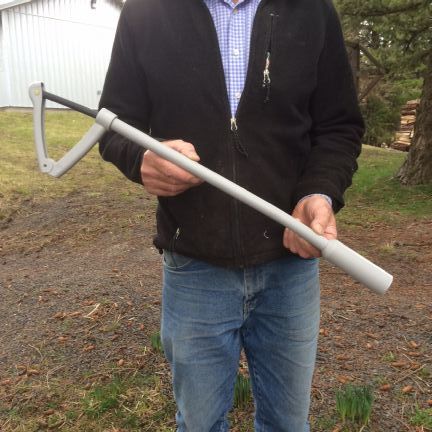 |
| CloversMum |
Posted - Feb 27 2016 : 09:08:20 AM
Cindy, I still LOVE Dr. Sarah's products and yes, they do work almost miraculously! :)
Now, I have some goats who love sucking on a syringe when I needed to give them meds for an infection a few years ago ... it was banana flavored and they came running when they saw me with it! Maybe the gel just needs a better flavor? |
| txbikergirl |
Posted - Feb 26 2016 : 5:18:56 PM
mary jane, after reading your post and looking at the photos i decided i wasn't up to the challenge. goodness, the people who told us how great it was made it sound like you just squeeze this treat like tube into your cow and it was done. not that i was taking their word and going to do it, but i didn't get the impression it was so awful. i prefer the method of just approaching diet correctly to avoid it all if possible, and am so grateful for everyone's advice here.
learn something new every day, keeps life exciting for sure. |
| txbikergirl |
Posted - Feb 26 2016 : 12:45:50 PM
charlene, that was a reference to the post where you just bought dr sarah's products online and the health issue cleared up before they even arrived.. so you deduced that her products were so good you just needed to buy them for them to work ;>
one of my fave posts of all time. |
| CloversMum |
Posted - Feb 26 2016 : 11:55:40 AM
I let the vet put our cows' magnets down their throat. Whatever unpleasant procedure that the vet can do that I don't have to do, then the choice is obvious! |
|
|
![[flourish]](/images/flourish-txt_mobius.png)
![[flourish]](/images/flourish-txt_mobius.png)